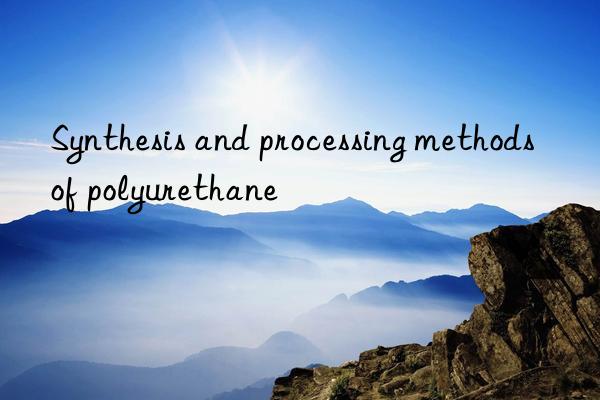
The synthesis method of polyurethane is based on chemical reactions , there are one-step method and two-step method. The so-called one-step method is to mix all the raw materials at one time or complete the chemical reaction process continuously to generate polyurethane products(made)The method of product. The two-step method, also known as the prepolymer method or the prepolymer method, is to react the oligomer polyol and the polyisocyanate first to form a prepolymer with a relatively low molecular weight, and then add a chain extender to react with the prepolymer to form a polyurethane product(Made)pin. The usual prepolymer is composed of oligomer polyol(Such as polyester, polyether)Prepared by reacting with excess diisocyanate. Among them, the content of volatile free diisocyanates is required to be relatively low. If the equivalent number of diisocyanate greatly exceeds the equivalent number of polyol(is more than 2 times), such a large amount of diisocyanate has nowhere to react and can only exist in the prepolymer in a free state, which is harmful to human health. But non-volatile isocyanates(such asMDI)Preparation The prepolymer allows the presence of more free isocyanate, and this prepolymer is actually a mixture of prepolymer and diisocyanate. The purpose of preparing this kind of prepolymer is mainly to reduce the viscosity of the prepolymer so that the viscosity and volume of the prepolymer component and the chain extension cross-linking agent are relatively close in the second step of the reaction, so as to improve the accuracy of the measurement. and blending effects. In order to distinguish it from prepolymers with lower free diisocyanate content, such prepolymers with high free isocyanate content can be called semi-prepolymers or semi-prepolymers. Synthesis of polyurethane products using semi-prepolymer(Made)The product method can be called semi-prepolymer method or semi-prepolymer method.
Polyurethane elastomers can be divided into three categories: casting type, thermoplastic type and mixing type polyurethane according to their product processing methods. With the expansion of polyurethane application fields and the continuous advancement of processing technology,after the 1970s, reaction injection molding, which is different from the above three traditional processing methods(RIM ), water-based polyurethane, spandex production and spray polyurea elastomer molding and other technologies have come out successively, and have formed their own complete processes and product systems.
CPU before processing and forming It is a viscous liquid, so it is called "liquid rubber". CPU elastomers are generally cross-linked polymers that react from liquid to solid to become the final product. It can be produced using a one-step or two-step process. The molding of its products can be vulcanized under pressure or under normal pressure; it can be hot vulcanized or cured at room temperature; it can be cast manually or continuously cast using a pouring machine. Therefore, the diversity of casting molding processes provides a lot of convenience for the production of large and medium-sized elastomer products. TPU and MPU are both solid before product processing and can be called "solid rubber".Glue". TPU and MPU are commonly produced by a one-step process, but it takes one or several steps to become a finished product. TPU is a combination of oligomer polyol and diisocyanate(such asMDI) and small molecular diol are metered and mixed into the twin-screw reactor for reaction, and then extruded and cut Granulate and dry for continuous production.The number average molecular weight of TPU is above 30,000 and the hardness is high(ShaoA65~Shao D85), using plastic processing equipment to produce products. Full thermoplasticTPU can also be coated with hot melt, or formulated with DMF, methyl ethyl ketone and other organic Solution, used to produce PU leather by dipping or coating method, or used as adhesive. MPU raw rubber is similar to fully thermoplastic TPU, and is also a hydroxyl-terminated linear polymer. But the molecular weight is lower(20000~30000), with higher soft segment content and greater plasticity. MPU raw rubber can be produced by batch method or continuously, and the products can be processed with general rubber processing equipment. Both TPU and MPU molded products need to be formed under heat and pressure, which places high requirements on mold manufacturing. Therefore, generally speaking, TPU and MPU are only suitable for processing small and medium-sized molded products. Among them, TPU tends to be harder(ShaoA70 and above)'s products, MPU tends to be softer(ShaoA80 or below) products. RIM polyurethane elastomer uses a high-pressure metering pump to transport low-viscosity, high-activity materials to a small-volume mixing head for impact, collision and mixing. Then, it is injected into the mold cavity and reacts quickly to solidify and form. The RIM process is mainly used to produce medium-low density self-skinning polyurethane microcellular elastomer products and basically bubble-free elastomer products. The temperature of the material system and mold is low(30~65℃), with low energy consumption and high production efficiency. ThereforeRIM product processing is different from TPU injection molding and CPU product processing. Spray polyurea is different from ordinary coatings in that it is a solvent-free, two-component rapid reaction system. Its material system is similar to cast liquid rubber, but has a high urea group content and a low urethane content. It has high activity, gels quickly, and can be solidified quickly. Spraying equipment is similar to RIM equipment, but does not require molds and has higher technical requirements. Therefore, spray polyurea technology starts from the material system and molding method. This makes up for the shortcomings of the above method and solves the problem that the above method cannot and is difficult to process and form. RIM and spray polyurea products are cross-linked polymers that are also liquid before molding the product. In this sense, it can also be called liquid rubber or liquid elastomer. But their discharge pressure is much higher than that of the pouring machine. In addition, non-foamed polyurethane elastomers have good machining properties.



 微信扫一扫打赏
微信扫一扫打赏
